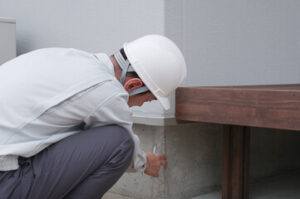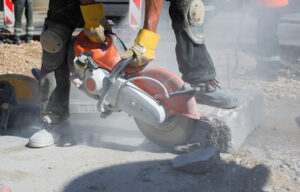Foundation Repair is a process of reinforcing and stabilizing the foundation under your home. The method chosen for your home depends on the composition of the soil under it.

Steel piers are the most permanent option but can be expensive. These galvanized steel piers are driven into the soil beneath your house until they reach stable, load-bearing bedrock or soil. Click Here to learn more.
Your foundation is the backbone of your home. It holds up every single structure and makes it possible for your family to live comfortably inside. But just like any other part of your house, the foundation needs to be cared for in order to continue functioning properly. If you are noticing signs that your foundation isn’t working the way it should, such as doors that stick or gaps developing in trim work, it’s important to have a professional evaluate and repair the problem as soon as possible before it worsens.
Once a professional has assessed the condition of your foundation, they will create a plan for how to best fix it. This typically involves the use of one or more methods that lift and support your foundation so it can get back to its original elevation. Most often, this will be achieved by using a method called slab jacking. Slab jacking is a process of pumping material into the concrete to raise hollow sections of the foundation. It’s a great solution for emergency foundation issues because it can be done quickly and doesn’t require excavation. There are different types of slab jacking materials, including high-density polyurethane foam, which is the preferred choice for raising highways and residential concrete.
Another common method of repairing foundations is to install carbon fiber wall reinforcement. This is an effective solution for walls that have a lot of movement in them. Helical tieback anchors can also be used to help straighten a bowed or leaning wall, and they are usually installed in the interior of the foundation under pressure.
The final method of restoring functionality is by installing new support piers underneath the foundation. This is the most expensive option but also the most effective for preventing future damage to your home’s foundation. Most of the time, these piers are located along the entire perimeter of your house. If the middle of your home requires support, this can be accomplished by using spot piers or segmented piers.
Restoring the Original Elevation
Foundation repair involves bringing the foundation back to its original elevation. The reason behind this is that the home was built to sit in a specific position, and all systems of the house work best if it stays there. A sunken foundation can sag and cause problems in the interior of the home, including leaky basements. Whether you’re dealing with just one section of a sinking foundation or the entire thing, a professional can bring your foundation back to its intended level.
Many homeowners are familiar with DIY projects like painting walls or installing new flooring. While there’s nothing wrong with that, some projects are more complex and require a professional for successful completion. This is especially true with foundation repairs. The process of excavating and drilling into your foundation walls requires a high degree of technical expertise, tools and materials not easily found at the local hardware store. A foundation repair company can provide these services with minimal disruption to your home and its contents.
After the repairs are complete, it is possible that some small cracks will appear in your home’s walls as it adjusts to its new position. These are not necessarily signs of further movement but rather a natural response to the changes in your home’s structure as it settles into its new position.
Depending on the severity of your foundation issues, a variety of different methods are used to stabilize and lift your foundation. For example, steel piers can be driven into the ground underneath your home to provide additional support to sinking portions of the foundation. Hydraulic jacks can then be attached to these piers to raise your foundation back to its desired elevation. Concrete piles are also a popular choice for repairing sunken foundations, and they can be installed in a similar fashion as steel piers.
In addition to re-leveling your foundation, some companies can also install a system called EverBrace that essentially creates a brand new wall inside of your existing foundation without the need for excavation and full reconstruction. The final step in a typical foundation repair is clean-up and restoration of the surrounding area. This may include re-landscaping and filling in any areas where soil was removed during the repair process.
Keeping Your Home Safe
The foundation of your home is more than just a structure; it’s an important investment and the very core of your sanctuary. But, as with any significant piece of architecture, the foundation can become vulnerable to external forces that could potentially knock it off-kilter. By understanding the critical signs of foundation damage, exploring effective repair methods, and implementing preventive strategies, homeowners can ensure that their homes are safe havens for their families.
Cracks in the walls, ceilings and concrete are common indicators of a failing foundation. These are a result of shrinking and expanding soils that put pressure on the foundation. The most important thing is to address these issues early, before they worsen and compromise the integrity of your home.
Water pooling around the foundation is another common sign of foundation problems. This is often caused by poor drainage, which can lead to the soil surrounding the foundation becoming saturated and weakening over time. Improving the drainage of your property through gutters, downspouts and grading can help to prevent excess moisture around your foundation.
Doorways that feel like they are auditioning for a horror movie, or windows that refuse to open are also telltale signs of a shifting foundation. This can cause the doors and windows to become misaligned, allowing water to seep through, creating costly repairs down the road.
If you notice a shifting of your foundation, it’s time to call in the experts. There are a number of different solutions to restoring your foundation, including slab jacking, which involves injecting a mixture beneath the foundation to lift it back to its original position. Piering and underpinning is a more intensive solution that involves installing metal piers or pilings underneath the foundation to support it. This allows the concrete to be lifted up into more stable soil layers, which is a little like giving your foundation a protein shake.
The key is to keep up with regular visual inspections of your property, especially during seasonal changes and weather events. Small horizontal and vertical cracks can be normal, but if they start to grow or change in shape, it’s definitely time to consult with a professional for repair or replacement.
Restoring Your Home’s Value
Some homeowners try to avoid the cost of foundation repair by selling their homes “as-is.” But ignoring a problem like this can actually increase your costs. Besides the fact that your home will be worth less with major damage to the foundation, you’ll likely incur other problems that are referred from the foundation like sagging floors, roof issues and cracks in the walls or ceilings. These types of “referred” symptoms can often be more expensive to repair than the original problem itself, so addressing the problem early on is more cost-effective in the long run.
It’s also important to remember that buyers are evaluating your home for its overall value. Many factors affect a home’s value, from curb appeal to the quality of its construction and upkeep. Foundation repairs are a great way to improve the appearance of your home and can help it look more appealing to potential buyers.
When it comes to repairing the foundation of your home, there are several different methods available that can restore the structural integrity and beauty of your home. Steel piers are a very common method that uses galvanized steel posts driven deep into the soil beneath your home to stabilize it. This is considered the best long-term solution for a foundation, and it can be used in almost any soil condition. Concrete piles are another alternative that consists of blocks or cylinders of pre-cured concrete, which are driven into the ground to support your home. Poured concrete piers are also a popular choice for this type of repair, which involves digging a large hole beneath your foundation, filling it with wet concrete and allowing it to cure before attaching it to your house.
Having a strong, stable foundation can allow you to do more with your home, whether you’re planning on making an addition or want to renovate the basement into a game room or additional living space. Buyers are more willing to pay a premium for a home that has been updated and well-maintained, and having an up-to-date foundation can make your renovations go smoothly.
